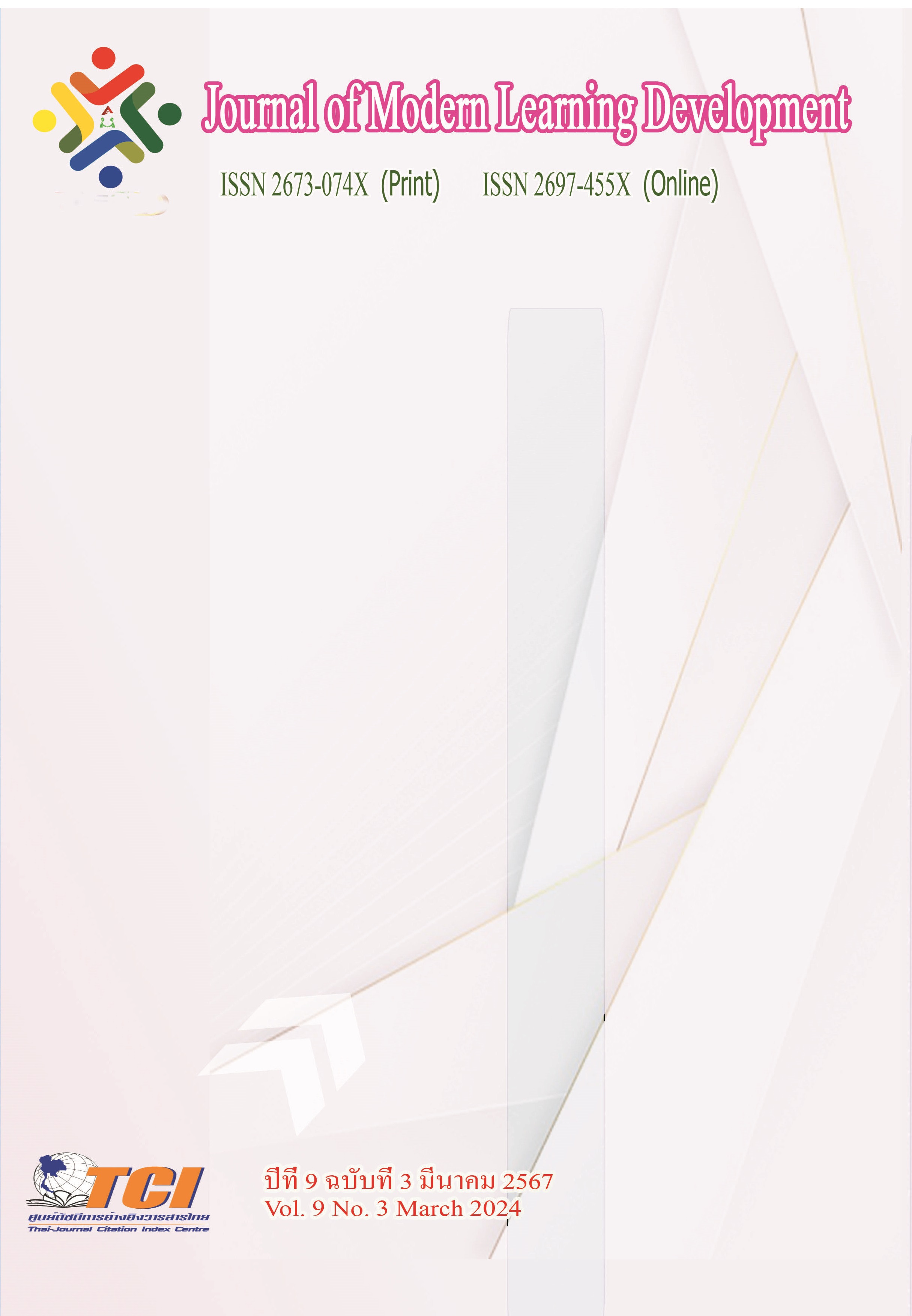Effects of Using the Stripling Model of Inquiry on Historical Reasoning of Upper Secondary Students
Main Article Content
Abstract
The purposes of this research were to study the learning management using the Stripling Model of Inquiry that affects the development of historical reasoning of upper secondary students, as experimental research The sample of this research consisted of 34 students in a classroom of tenth grade students studying in the first semester of the academic year 2022 in Rittiyawannalai 2 school, Sai Mai District, Bangkok randomly selected by simple random sampling. by making lucky drawings for using classrooms as random units. Research tools include: the historical learning management lesson plans using the Stripling Model of Inquiry and the historical reasoning Assessment. Data were collected by evaluating historical reasoning from students' work in the three phases and analyzing the research results by arithmetic mean (M), standard deviation (S.D.), and Repeated measures ANOVA.
The research findings were summarized as follows the learning management using the Stripling Model of Inquiry resulted in the historical reasoning of students had higher development at .05 level of significance, with development from phase 1 to phase 2 and phase 3 was higher in all phases.
Article Details
References
เฉลิม มลิลา นิติเขตต์ปรีชา. (2559). เทคนิควิธีการสอนประวัติศาสตร์. (พิมพ์ครั้งที่ 6). กรุงเทพมหานคร: สำนักพิมพ์แห่งจุฬาลงกรณ์มหาวิทยาลัย
ชัยรัตน์ โตศิลา. (2555). การพัฒนากระบวนการเรียนการสอนโดยใช้วิธีการทางประวัติศาสตร์ เพื่อส่งเสริมทักษะการคิดทางประวัติศาสตร์ของนักเรียนมัธยมศึกษาปีที่ 2. วิทยานิพนธ์ครุศาสตรดุษฎีบัณฑิต. สาขาวิชาหลักสูตรและการสอน คณะครุศาสตร์. บัณฑิตวิทยาลัย: จุฬาลงกรณ์มหาวิทยาลัย.
รัชนีกร หงส์พนัส. (2564). การพัฒนาครูสังคมศึกษาในฐานะนวัตกรการจัดการเรียนรู้ประวัติศาสตร์ในยุคดิจิทัล. กรุงเทพมหานคร: พรรณีพริ้นติ้งเซ็นเตอร์.
วลัย อิศรางกูร ณ อยุธยา. (2555). ครูสังคมศึกษากับการพัฒนาทักษะแก่นักเรียน. กรุงเทพมหานคร: คณะครุศาสตร์ จุฬาลงกรณ์มหาวิทยาลัย.
ศศิพัชร จำปา. (2562). กระบวนการสืบสวนและการตีความทางประวัติศาสตร์: การเรียนรู้ด้วยวิธีปฏิบัติการประวัติศาสตร์. Veridian E-Journal. 12 (5), 974-988.
ศจีมาจ ณ วิเชียร. (2555). การออกแบบการวิจัยเชิงปริมาณ. ออนไลน์. สืบค้นเมื่อ 20 ตุลาคม 2565. แหล่งที่มา: http://rlc.nrct.go.th/ewtadmin/ewt/nrct_museum/ewt_dl.php?nid=911
ศุภณัฐ พานา. (2563). แนวทางในการจัดการเรียนการสอนประวัติศาสตร์. วารสารสังคมศาสตร์ มหาวิทยาลัยศรีนครินทรวิโรฒ. 23 (2), 390-399.
สิริวรรณ ศรีพหล. (2553). การจัดการเรียนการสอนวิชาประวัติศาสตร์ในสถานศึกษา. นนทบุรี: สำนักพิมพ์มหาวิทยาลัยสุโขทัยธรรมาธิราช.
สำนักงานคณะกรรมการการศึกษาขั้นพื้นฐาน. (2558). การสอนประวัติศาสตร์ ประวัติศาสตร์ไทย หลายหลายวิธีเรียน. กรุงเทพมหานคร: โรงพิมพ์ชุมนุมสหกรณ์การเกษตรแห่งประเทศไทย จำกัด.
สำนักงานเลขาธิการสภาการศึกษา. (2564). รายงานการศึกษาวิจัย เรื่อง สภาพการจัดการเรียนการสอนวิชาประวัติศาสตร์ ระดับการศึกษาขั้นพื้นฐาน. กรุงเทพมหานคร: กลุ่มพัฒนานโยบายด้านการมีส่วนร่วมและสมัชชาการศึกษา และกลุ่มพัฒนานโยบายด้านการเรียนรู้ สำนักมาตรฐานการศึกษาและพัฒนาการเรียนรู้ สำนักงานเลขาธิการสภาการศึกษา กระทรวงศึกษาธิการ
Barton, Keith C. and Levstik, Linda S. (2004). Teaching History for the Common Good. Mahwah, NJ: Lawrence Erlbaum Associates.
Dillenburg, M. (2017). Understanding historical empathy in the classroom. Dissertation Ed.D. School of Education : Boston University.
Kalmon, Stevan; et al. (2012). From Corn Chips to Garbology: The Dynamics of Historical Inquiry. OAH Magazine of History. 26 (3), 13-18.
Luís, Rita and Rapanta, Chrysi. (2020). Towards (Re-)Defining historical reasoning competence: A review of theoretical and empirical research. Educational Research Review. 31, 100336.
Stripling, Barbara. (2009). Inquiring Minds Want to Know: Using Primary Sources to Guide Inquiry-Based Learning. Online. Retrieved October 27, 2019. from http://citeseerx. ist.psu.edu/viewdoc/download?doi=10.1.1.832.585&rep=rep1&type= pdf
Stripling, Barbara. (2010). Teaching Students to Think in the Digital Environment: Digital Literacy and Digital Inquiry. School Library Monthly. 25 (8), 16-19.
Stripling, Barbara. (2014). Inquiry in the Digital Age. In Inquiry and the Common Core: Librarians and Teachers Designing Teaching for Learning, 93-105. Edited by Violet H. Harada and Sharon Coatney. Santa Barbara: ABC-CLIO, LLC.
van Drie, Jannet and van Boxtel, Carla. (2007). Historical Reasoning: Towards a Framework for Analyzing Students’ Reasoning about the Past. Educational Psychology Review. 20, 87-110.
van Drie, Jannet; Braaksma, Martine and van Boxtel, Carla. (2015). Writing in History: Effects of writing instruction on historical reasoning and text quality. Journal of Writing Research. 7 (1), 123-156.


